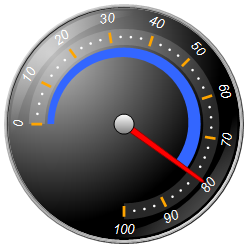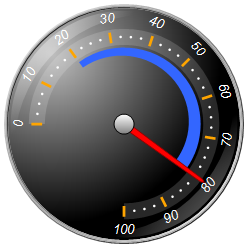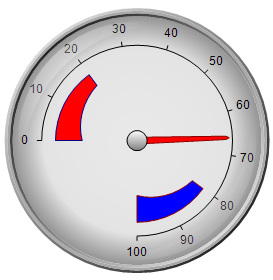The range indicator has three properties that combined determine the scale range of the indicator. The first one is called Value and it controls either the begin or end value of the range depending of which one is bigger.
The OriginMode property allows you to anchor the range to the scale min, scale max or a custom value as shown by the following table:
| Range indicator with origin set to ScaleMax and Value set to 80 | Range indicator with origin set to ScaleMin and Value set to 80 | Range indicator with origin set to Custom, Value set to 80 and Custom set to 20 |
|---|---|---|
 |
 |
 |
The following code will create two range indicators – the first one spans [ScaleMin, 20] and the second one spans [80, ScaleMax]:
| C# |
Copy Code
|
|---|---|
nChartControl1.Panels.Clear(); NRadialGaugePanel radialGauge = new NRadialGaugePanel(); nChartControl1.Panels.Add(radialGauge); radialGauge.ContentAlignment = ContentAlignment.BottomRight; radialGauge.Size = new NSizeL(new NLength(100, NRelativeUnit.ParentPercentage), new NLength(100, NRelativeUnit.ParentPercentage)); radialGauge.Location = new NPointL(new NLength(0), new NLength(0)); radialGauge.SweepAngle = 270; radialGauge.PaintEffect = new NGlassEffectStyle(); radialGauge.BorderStyle = new NEdgeBorderStyle(BorderShape.Auto); NAdvancedGradientFillStyle ags = new NAdvancedGradientFillStyle(); ags.BackgroundColor = Color.Black; ags.Points.Add(new NAdvancedGradientPoint(Color.LightGray, 50, 50, 0, 100, AGPointShape.Circle)); ags.Points.Add(new NAdvancedGradientPoint(Color.White, 50, 50, 0, 60, AGPointShape.Circle)); radialGauge.BackgroundFillStyle = ags; NGaugeAxis axis = (NGaugeAxis)radialGauge.Axes[0]; NStandardScaleConfigurator scale = (NStandardScaleConfigurator)axis.ScaleConfigurator; scale.SetPredefinedScaleStyle(PredefinedScaleStyle.Scientific); NRangeIndicator rangeIndicator1 = new NRangeIndicator(); rangeIndicator1.OriginMode = OriginMode.ScaleMin; rangeIndicator1.Value = 20; rangeIndicator1.BeginWidth = new NLength(-20); rangeIndicator1.EndWidth = new NLength(-10); rangeIndicator1.FillStyle = new NColorFillStyle(Color.Red); rangeIndicator1.StrokeStyle = new NStrokeStyle(Color.DarkRed); rangeIndicator1.OffsetFromScale = new NLength(-10); radialGauge.Indicators.Add(rangeIndicator1); NRangeIndicator rangeIndicator2 = new NRangeIndicator(); rangeIndicator2.OriginMode = OriginMode.ScaleMax; rangeIndicator2.Value = 80; rangeIndicator2.BeginWidth = new NLength(-10); rangeIndicator2.EndWidth = new NLength(-20); rangeIndicator2.FillStyle = new NColorFillStyle(Color.Blue); rangeIndicator1.StrokeStyle = new NStrokeStyle(Color.DarkBlue); rangeIndicator2.OffsetFromScale = new NLength(-10); radialGauge.Indicators.Add(rangeIndicator2); NNeedleValueIndicator needleIndicator = new NNeedleValueIndicator(); needleIndicator.Value = 66; needleIndicator.OffsetFromScale = new NLength(-2); needleIndicator.Shape.FillStyle = new NColorFillStyle(Color.Red); radialGauge.Indicators.Add(needleIndicator); |
|
| Visual Basic |
Copy Code
|
|---|---|
Dim radialGauge As NRadialGaugePanel = New NRadialGaugePanel() nChartControl1.Panels.Add(radialGauge) radialGauge.ContentAlignment = ContentAlignment.BottomRight radialGauge.Size = New NSizeL(New NLength(100, NRelativeUnit.ParentPercentage), New NLength(100, NRelativeUnit.ParentPercentage)) radialGauge.Location = New NPointL(New NLength(0), New NLength(0)) radialGauge.SweepAngle = 270 radialGauge.PaintEffect = New NGlassEffectStyle() radialGauge.BorderStyle = New NEdgeBorderStyle(BorderShape.Auto) Dim ags As NAdvancedGradientFillStyle = New NAdvancedGradientFillStyle() ags.BackgroundColor = Color.Black ags.Points.Add(New NAdvancedGradientPoint(Color.LightGray, 50, 50, 0, 100, AGPointShape.Circle)) ags.Points.Add(New NAdvancedGradientPoint(Color.White, 50, 50, 0, 60, AGPointShape.Circle)) radialGauge.BackgroundFillStyle = ags Dim axis As NGaugeAxis = CType(radialGauge.Axes(0), NGaugeAxis) Dim scale As NStandardScaleConfigurator = CType(axis.ScaleConfigurator, NStandardScaleConfigurator) scale.SetPredefinedScaleStyle(PredefinedScaleStyle.Scientific) Dim rangeIndicator1 As NRangeIndicator = New NRangeIndicator() rangeIndicator1.OriginMode = OriginMode.ScaleMin rangeIndicator1.Value = 20 rangeIndicator1.BeginWidth = New NLength(-20) rangeIndicator1.EndWidth = New NLength(-10) rangeIndicator1.FillStyle = New NColorFillStyle(Color.Red) rangeIndicator1.StrokeStyle = New NStrokeStyle(Color.DarkRed) rangeIndicator1.OffsetFromScale = New NLength(-10) radialGauge.Indicators.Add(rangeIndicator1) Dim rangeIndicator2 As NRangeIndicator = New NRangeIndicator() rangeIndicator2.OriginMode = OriginMode.ScaleMax rangeIndicator2.Value = 80 rangeIndicator2.BeginWidth = New NLength(-10) rangeIndicator2.EndWidth = New NLength(-20) rangeIndicator2.FillStyle = New NColorFillStyle(Color.Blue) rangeIndicator1.StrokeStyle = New NStrokeStyle(Color.DarkBlue) rangeIndicator2.OffsetFromScale = New NLength(-10) radialGauge.Indicators.Add(rangeIndicator2) Dim needleIndicator As NNeedleValueIndicator = New NNeedleValueIndicator() needleIndicator.Value = 66 needleIndicator.OffsetFromScale = New NLength(-2) needleIndicator.Shape.FillStyle = New NColorFillStyle(Color.Red) radialGauge.Indicators.Add(needleIndicator) |
|
This code will result in the following gauge configuration:

